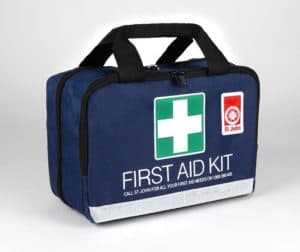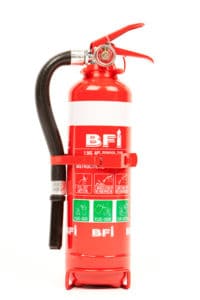
What type of fire and safety equipment do you need in a work vehicle?
We all know what Work Health and Safety (WHS) control measures we need to put in place for our workshop, office, warehouse, factory or shop. But what about vehicles such as cars, vans and trucks? This article is our recommendations on what you should do with these vehicles.
In the Work Health and Safety Act of South Australia a “workplace” is defined as
- … a place where work is carried out for a business or undertaking and includes any place where a worker goes, or is likely to be, while at work.
- In this section— place includes—
- a vehicle, vessel, aircraft or other mobile structure; and …
This definition clearly states therefore that any vehicle is a workplace. While many organisations clearly identify trucks as a workplace a sales rep or manager’s car or a tradesman’s van are often overlooked and it will be these that we will focus on.
First Aid

The WHS Regulations place specific obligations on the organisation in relation to first aid, including requirements to:
For office based vehicles this would include a complying First Aid Kit and as the driver is often alone in the vehicle, basic first aid training.
For tradesman and service vans the first aid kit requires additional equipment due to the higher risk associated with the work being undertaken.
These first aid kits must also be maintained and out of date or used products replaced. This is often best done by a single person or outsourced to a specialist provider. Riverland Fire & Safety does offer a yearly inspection of first aid kits as part of our programmed services.
Emergency Plans
The WHS Regulations place specific obligations on the organisation in relation to emergency planning, including requirements to:
- provide emergency procedures for likely emergencies to be experienced at the workplace
- training in the use of and testing of the emergency procedures
- adequate emergency facilities and equipment
While we are aware of the normal Emergency Plan and associated scenarios in a workplace there are other emergencies that are unique to a vehicle, such as:
- Flat tyre
- Engine failure
- Vehicle fire
- Car crash
These scenarios should be integrated into the Emergency Plan.
The user of the vehicle should be trained in the application of these procedures. This should be formal training every 2 years and drills every 6 months.

Adequate emergency equipment should be contained within the vehicle to support these emergency procedures and would, at a minimum include:
The emergency equipment, such as fire extinguishers must also be maintained. This is often best done by a single person or outsourced to a specialist provider. Riverland Fire & Safety does offer a 6 monthly inspection of fire extinguishers and other emergency equipment as part of our programmed services.
Personal Protective Equipment (PPE)
The WHS Regulations require an organisation to provide its workers with adequate PPE. As a minimum this would include a safety vest (day and night type) for moving around the vehicle while on the road as well as a torch.
Remote or Isolated Work

When you think of remote work you might think of the Australian bush or farmland but many vehicles are driven down rural roads or in bushfire prone areas. The WHS Regulations require adequate procedures and communication systems for dealing with hazards in these locations. For most situations this would include
If you are struggling with what to include in a bushfire plan then review the CFS website or contact Riverland Fire & Safety as we have our own templated bushfire plan for our service technicians.
Need more help
There are a number of organisations that can assist you comply with your WHS requirements for vehicles including
- Safe Work SA
- WHS consultants
- Riverland Fire & Safety
So don’t wait until it’s too late, start reviewing the WHS facilities, procedures and training associated with your fleet of vehicles.